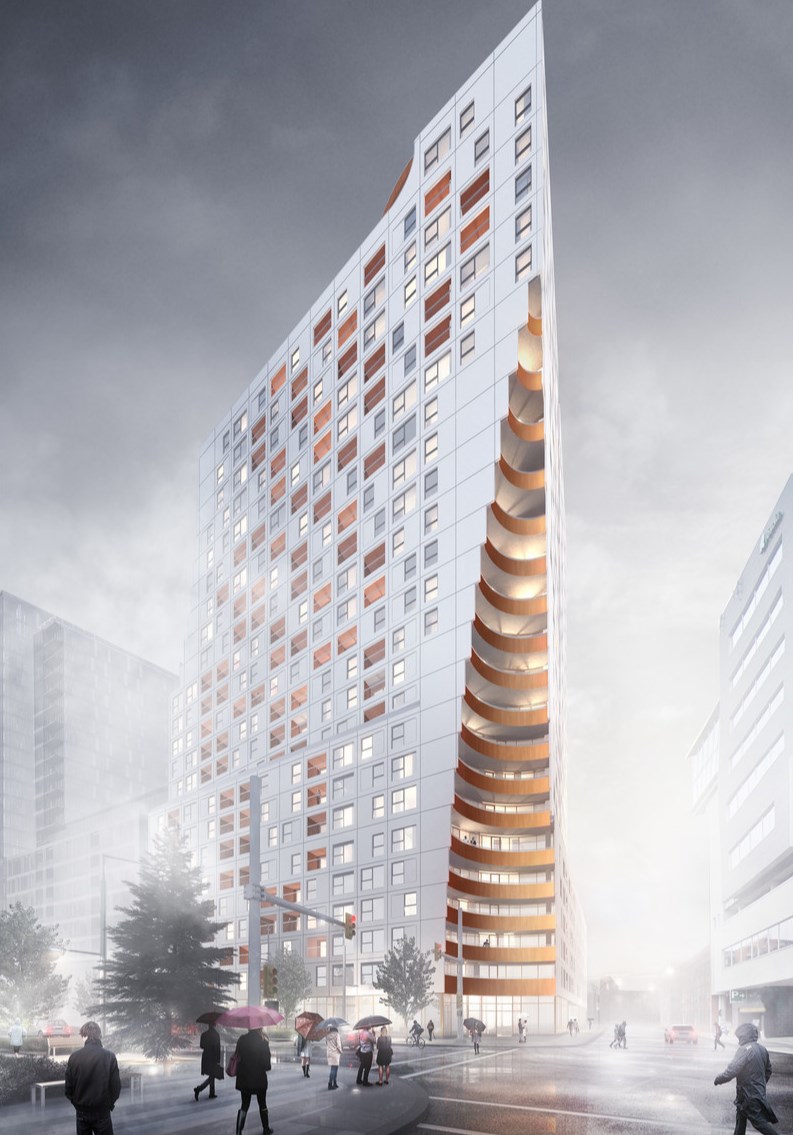The Cree Nation has unveiled plans for an ambitious $100 million high-rise tower that will stand at one of the main entrances to downtown Montreal. Featuring a giant canoe shape at its most prominent corner, the 26-floor Odea Montreal building will accommodate a combination of condos, rentals and commercial space.
“I am proud to see my Nation’s contribution to the Montreal skyline with an innovative and forward-thinking project that will not only showcase the history of the Cree Nation, but more importantly will also create space for Indigenous organizations and entities,” stated Grand Chief Mandy Gull-Masty. “The Odea Montreal project is the first of its kind and will be an economic driving force with endless opportunities for additional investment.”
At least 40 different companies had approached Creeco about a site the CNG has owned in Old Montreal since 1995 before a partnership was formed with Cogir Real Estate. While Creeco considered offers as high as $40 million, they preferred to be involved in development and determined that long-term revenue would justify this initiative.
World-renowned Anishinaabe architect Douglas Cardinal created the project’s bold design in collaboration with local architectural firm Lemay. Famous in the Cree Nation for designing the village of Ouje-Bougoumou and the Aanischaaukamikq Cree Cultural Institute, Cardinal was brought on board after Mayor Valérie Plante pushed the team to build something unique.
“The mayor of Montreal considered the first concept of our project ‘very generic’, in her words,” explained Derrick Neeposh, president of Creeco, the parent company of Eeyou Eenou Realty Properties. “Douglas’ name came up very early. His reputation, expertise and style of design was very welcome by Lemay. We really wanted to put a stamp on it to say this is a Cree project.”
When Cardinal visited the site, he immediately had a powerful vision of a canoe. A vision session soon after that included Elders Robbie Matthew and Diane Reid confirmed it was the perfect symbol, evoking the epic Odeyak journey that brought Cree and Inuit activists all the way from Whapmagoostui to New York City in 1990 to successfully campaign against the proposed damming of the Great Whale River.
“The canoe is a symbol of communication and commerce, trade and amazing technology that Indigenous people created out of their natural environment,” Cardinal told the Nation. “The Odeyak developed good relationships as the people shared who they were in a very powerful way – (this project) is a vehicle to serve their people and the people of Montreal.”
The Odeyak’s triumphant voyage resulted in New York State pulling out of a deal to purchase power from the project. Now the Odea signals the empowered Cree Nation’s resolve to generate wealth in the south for the benefit of the North, with a building ironically located on the corner of Ottawa Street and Robert Bourassa Boulevard – named after the premier who had so ardently promoted the Great Whale project.
“We’re just proud of the fact we have an iconic building on Robert Bourassa Boulevard as a Cree project,” Neeposh emphasized. “We want to integrate our culture into it, bringing in different Cree organizations, even hosting Cree events. Throughout the building, we’re thinking of subtle identifying components, the title in Cree syllabics, for example.”
While the limited office space and costly real-estate may make renting to Cree entities unfeasible, Neeposh said the building’s birch-influenced interior design affirms the tree’s importance in Cree toolmaking, including the ongoing creation of canoes. Odea is targeting a LEED silver certification to promote environmental sustainability in material usage and energy consumption.
The building will feature an artist’s studio, two rooftop pools, a sky lounge and green spaces for everyone to enjoy. In acknowledgement that they are developing on unceded Kanien’kehà:ka territory, Elder Kevin Ka’nahsohon Deer was invited for the recent groundbreaking ceremony.
“It gave us the sense of welcoming and belonging, but more importantly that we respected their territory,” Neeposh told the Nation. “Inclusion is very important. I had a brief discussion with the Grand Chief who is his daughter, Kahsennenhawe Sky-Deer. True reconciliation lies in working relationships we establish with other First Nations.”
As an architect, establishing strong relationships with diverse stakeholders has been essential for Cardinal to achieve such impressive projects. His process always begins with a vision session gives shape to client needs, designing complex organic forms with computer modelling.
“We have to use our technology to create more balance with our beautiful blue planet,” explained Cardinal. “I made a commitment to my Elders to be an architect of the people, to be an architect more in harmony with our Mother, the Earth. I incorporate those spiritual values in every building I do.”
Cardinal feels a responsibility to integrate his culture’s wisdom into architecture. To maintain humility before nature, he has conducted his own sweat-lodge ceremonies weekly over the past 50 years. Working again with the Crees on this project, he could hear the teachings of his Elders.
“It’s exciting working for them because they will have a strong vision for what they need and want for their people,” Cardinal said. “It has always been a highlight of my career to serve the James Bay Cree. It will be fun to walk in the building – I wanted it to feel the spirit of the Elders.”
When Cardinal was asked to plan the village of Ouje-Bougoumou about 30 years ago, he had just completed the celebrated Canadian Museum of History in Gatineau after decades of innovative projects in Alberta. Listening to the people’s stories and dreams in a simple shaptuan, he became inspired to turn their vision into reality.
“When we started that village, the people were living in tarpaper shacks, just surviving,” Cardinal recalled. “I always tell the story of how the Crees carried out their vision – they had the energy and spiritual fortitude to make it happen. It’s an example for all Indigenous people across Canada.”
Patrick Quinn is a federally funded Local Journalism Initiative Reporter at The Nation



